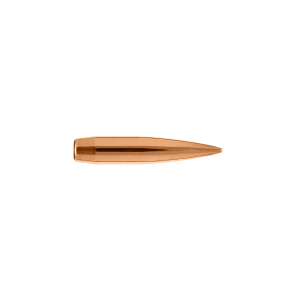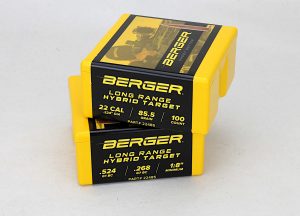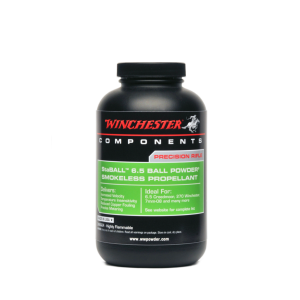By Art Merrill | Contributing editor
There was a time when I was shooting the M-14 with a Navy High Power team that we dismissed the M-16 as a mouse gun that could never compete at 600 yards.
Never say never, they say, and today improvements in the 5.56/.223 Rem cartridge, as well as the M16/AR-15 platform, make it a winner at the 600 yard line where the M-14 is now virtually extinct and the civilian version M1A merely a curiosity.
That “mouse gun” skepticism has still endured at the 1,000 yard line all these years, but without any vehemence, as competitors having gained wisdom with experience and watching the mouse gun reach ever further with improved, heavier bullets and faster twists. Today, we occasionally see the adventurous stretching the 5.56/.223 to 1,000 yards, and in October 2019 Berger may well have broken that 1,000-yard mouse gun barrier with their new bullet.
Making the mouse roar

Berger’s new 1,000 yard .224” 85.5gr lanky bullet is of their hybrid ogive design.
(Photo courtesy Berger Bullets)
Berger’s new .22 caliber 85.5 grain Long Range Hybrid Target bullet is, as the name says, of hybrid ogive design, a subject we’ve covered before here. The new 85.5 grainer boasts a G1 ballistic coefficient of .524, (and a G7 of .268), and while it may shoot well in a 1:8 twist, Berger recommends giving it a 1:7 to assure optimum stability.
According to Berger, started at 2,800 fps in that 1:7 twist, the new .22 bullet wind drifts about 15 percent less than a 155 grain .308 bullet. If you’re a High Power shooter, the comparison is noteworthy because the latter has long been a popular bullet/cartridge for Palma and Fullbore competition that go out to 1,000 yards.

Berger’s 2019 late-comer is an 85.5gr bullet to stretch the legs of centerfire .22s.
But can we reach 2,800 fps with the new bullet in a 5.56/.223 chambered AR-15? While Berger is still working on publishing load data for the new bullet, it’s safe to utilize data from the Berger Reloading Manual for their 90 grain Match VLD Target bullet. Here, we find that maximum listed bullet velocity is 2,595 fps. Moving over to Berger’s online ballistics calculator and selecting the new bullet from the dropdown menu, the default muzzle velocity already plugged in is a bit more, 2650 fps. Ignoring that and starting the bullet at 2,595 fps velocity at sea level, the bullet is still supersonic (1,192 fps) at 1,000 yards, a critically important factor, as accuracy goes out the window when a bullet hits the sonic-to-subsonic transition wall. Increasing velocity to 2,800 fps in the calculator gains us another 139 fps at 1,000 yards.
Even if cartridge gas pressures won’t let us get 2,800 fps with that bullet in an AR-15, it appears 2,595 fps will still afford us some wind drift performance improvement over that 155 grain .308 bullet. For competitors, in Berger’s .22-caliber 85.5 grain Long Range Hybrid Target bullet stretching the 5.56/.223 from 600 out to 1,000 yards, the new bullet affords an opportunity to A.) shoot a rifle/cartridge with less recoil than the 7.62/.308 produces, B.) reload with about half the powder we’d use in a 7.62/.308 case and C.) utilize a single AR-15 across multiple disciplines – High Power Service Rifle, Palma and Fullbore, as well as a variety of other long range precision rifle games.
Competing in 2020
Those who precision-shoot other .22 centerfires like the .22 Creedmoor and .224 Valkyrie – and varmint hunters who shoot the .22-250, 220 Swift, et al – should take a look at the new bullet, as well. Of course, as with all super-heavy-for-caliber .224” bullets reaching 75 or so grains and more, in seating these longer bullets well out of the cartridge to maintain powder space, cartridge overall length becomes such that feeding through magazines isn’t possible, so these 85.5 grainers are single-loading propositions only in the smaller cases.
We can probably expect to start seeing Berger’s 85.5 grainers at the 600-yard line in Service Rifle competition this season (winter, here in Arizona), and bigger fish are already frying: “The US Rifle Team was instrumental in the bullet’s development,” Berger spokesman Geoff Esterline said in an email exchange, “and they look forward to further testing and competition for their 2020 season.”
MSRP for the new Berger .22 caliber 85.5 grain Long Range Hybrid Target bullet is $41.99 per box of 100. Get more info at https://bergerbullets.com/ where you’ll also find Berger’s free ballistics calculator.
Hodgdon releases Winchester StaBALLTM 6.5

Winchester StaBALL 6.5, another 2019 late arrival, may be a good match for the new Berger bullet. Testing with the heavy bullet in smaller cases will determine suitability.
Also a late 2019 bloomer, in October Winchester announced release of StaBALL 6.5 smokeless powder, calling it, “…the world’s first temperature-insensitive BALL® Powder, stable in extreme-hot or -cold conditions.”
“We identified a market need for a high-performing powder that metered precisely to be loaded on a progressive press, featured temperature insensitivity and a copper fouling elimination agent,” Hodgdon Chief Ballistician Ron Reiber said in a press release (Hodgdon is the licensed distributor of Winchester Smokeless Propellants).
In an old-school marketing play on words, StaBALL 6.5’s feature benefit is its stability in producing consistent pressure across a wide temperature spectrum. What this means for us is that the bullet velocities we develop in a load during a freezing mountain winter will remain the same during a hot fall low-desert muley hunt, and we don’t have to worry about our cartridges baking in the summer sun during a Long Range competition and subsequently throwing bullets well away from the rifle’s normal zero determined with cooler cartridges. At least, these are what “extreme” temperatures mean to me in a practical sense.
If you’ve reloaded extruded powders on a progressive press, or even thrown charges from a measure, you know the way the powder granules sometimes hang up and are cut by the rotor can swing your Happy Meter needle into the “Annoying” and “Frustrating” zones. As its other wordplay name implies, StaBALL 6.5 is a ball-type powder, which flows easily through a powder measure, compared to extruded powders. This helps keep that needle in the green when reloading goes without speed bumps and charges are consistent. Precise metering equates to consistent velocities and lower standard deviations, both results we can measure with a chronograph.
Another advantage to ball-type powders is that they can often safely provide higher velocities than extruded powders in their class/burn rate due to improved loading density. Hodgdon says StaBALL 6.5 can up velocities 30 to 200 fps in cartridges for which it is ideally suited, such as 6mm Creedmoor, 6.5 Creedmoor, 7MM-08 and 270 Winchester. Hodgdon has already posted loads for these and other cartridges on its free, online Reloading Center. Among them are loads for the .223 Remington with 90 grain bullets – hello, Berger 85.5 grain Hybrid – so perhaps mating the powder and heavy bullet in the smallish .223 Rem case will be a happy match.
Lastly, StaBALL 6.5 includes an additive (tin, if memory serves) to reduce copper fouling from jacketed bullets, a real benefit for competition shooters more so than for hunters. All these benefits, especially its applicability across a wide range of mid-size cartridges, make StaBALL 6.5 worth investigating. A one-pound canister is a good place to start, and if that turns out well, StaBALL 6.5 is also available in cost-saving eight-pound canisters.



